It doesn't look or feel like anywhere else in southern France.
This wild region brims with the untamed natural beauty of salt marshes, reed beds, free-roaming Horses and hundreds of bird species – most notably, Greater Flamingos.
 |
| Unexpected in France; Photo: Scott Stevens |
What????
Camargue National Park, designated in 1970, protects a wetland environment, lagoon and adjacent marine area at Europe's largest delta, where the Rhône River creates marshlands as it empties into the Mediterranean Sea. Near Arles, the area has paddies where France’s only domestic rice crop is grown, pink salt flats, marshes and beaches.
 |
| Salt flat |
Three interesting local residents are Raço di Biòu and Brava Cattle and Carmargue Horses, all raised in semi-feral conditions and wrangled by area cowboys called gardians.
 |
| Gardian statue in Saintes-Maries-de-la-Mer; Photo: Scott Stevens |
Native to these unexpected marshlands, the black (occasionally dark brown) Raço di Biòu Bull is central to the traditional sport of Course Camarguaise. In this bloodless bullfight, the gardians drive a castrated bull into a ring and “raseteurs” try to remove a cockade from the bull’s forehead or horns. Bulls weigh about 800 lbs.; females are much smaller at 500, which is still substantial. The horns are very large and dangerous looking with an upright orientation. So, while Course Camarguaise may be bloodless for Bulls, I am not so sure about the raseteurs.
 |
| Statue in town; Photo: Scott Stevens |
Brava, or Race de Combat, Cattle, also live in the Camargue. They are bred specifically for bullfighting, either Spanish-style (on foot) or Portuguese-style (on horseback). The Brava derives from Iberian fighting cattle imported in the 19th Century and is known as the Espagnole Brava. They vary in color, but are most often black. The horns are large and, unlike the Raço di Biòu, forward-pointing.
Both breeds live in herds called manades. We saw one small herd as we drove in, deciding that we would go back later for photos. We never saw any again. We did, however, see lots of representations of them in the little town of Saintes-Maries-de-la-Mer.
 |
| Unfortunately, no bullfights were on tap when we were there |
Camargue Horses
The horses the gardians ride are also a local darling.
 |
| Two very white adults; Photo: Scott Stevens |
Camargue Horses are born with a black or dark brown coat that turns white as they grow to adulthood. But, since their underlying skin is black, they can look soft gray.
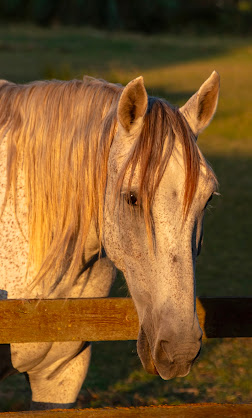 |
| A juvenile; Photo: Scott Stevens |
Considered rugged and intelligent, they have a tranquil temperament.
Camargue Horses have a short neck, compact body, strong limbs and a full mane and tail. The head is heavy and square, with wide-set eyes, a straight profile, flat forehead and chiseled cheek bones. The ears are small, short and set apart. Hooves are tough, with large and wide soles suited to their marshy habitat.
 |
| Stretching and rolling |
We saw quite a few, most gathered in manades. The best ones to photograph were actually at our hotel, which appeared to be a manade-turned-inn.
 |
| Our Innkeeper feeding the horses on her property |
The Camargue Horse’s origins are unknown. For possibly thousands of years, they lived wild in the harsh environment of the Camargue marshes and wetlands of the Rhône delta.
 |
| Grazing with some Cattle Egrets |
Some researchers believe Camargue Horses are descended from the prehistoric Solutré horses in Burgundy. Their genealogy is closely tied with Iberian horses, especially those of the northern part of the peninsula.
In Camargue, there are about 20,000 Raço di Biòu Cattle, 5,000 Brava Cattle and 14,000 Camargue Horses.
Greater Flamingos
What I really wanted to see was the Flamingos. My research seemed to indicate that there should be some at the Parc Ornithologique du Pont de Gau, a beautiful birding park near our hotel.
But, I was concerned that, by September, they would have migrated south. I couldn’t find anything definitive, so we went with crossed fingers. We actually stopped there as soon as we arrived and then went back the next morning.
Did I see a Flamingo?
Although I had seen some literature that boasted of both Lesser and Greater Flamingos, we saw only Greater, which was a lifer for me. These birds are lighter than the American Flamingos I saw in Ecuador, ranging from almost white to light pink.
 |
| Not as bright pink as other Flamingos |
Their legs are bright pink; their prodigious bills are pink and black. Their eyes are yellow.
 |
| The eyes are amazing |
They are most impressive when they unfurl their wings or take to the air to reveal vibrant hot pink and black.
The most widespread of the Flamingo family, Greater Flamingos are common in the Old World, found in Northern (coastal) and Sub-Saharan Africa, the Indian Subcontinent (south of the Himalayas), the Middle East, the Levant, the Persian Gulf, the Gulf of Aden, the Red Sea and the Mediterranean countries of Southern Europe.
 |
| A tightly packed group |
 |
| The wingspan is about five feet |
This bird is the largest living species of Flamingo, averaging 43 to 59 inches tall and weighing 4.4 to 8.8 lbs. (literally the height of an adult human and the weight of a newborn). The largest males have been recorded to be up to 74 inches tall and to weigh almost 10 lbs.
Chicks are covered in gray fluffy down. Subadult Flamingos are paler with dark legs.
 |
| A juvenile |
Adults feeding chicks also become paler, but retain the bright pink legs. The coloration comes from the carotenoid pigments in the organisms they eat.
Greater Flamingos were previously thought to be the same species as the American Flamingo, but because of coloring differences of its head, neck, body and bill, the two are now most commonly considered separate species.
At Parc Ornithologique, the Greater Flamingos grouped together, sometimes getting annoyed with each other.
They live in mudflats and shallow coastal lagoons with salt water. Using their feet, they stir up mud, then suck water through their bills to filter out small shrimp, brine shrimp, other crustaceans, seeds (such as rice), blue-green algae, microscopic organisms (such as diatoms), insect larvae (such as chironomids) and mollusks.
Adults have few natural predators; eggs and chicks may be eaten by raptors, Crows and Gulls.
The typical lifespan in captivity is over 60 years; in the wild, the average lifespan is 30 to 40 years.
Lots of Birds
On my second visit, I walked most of the Parc’s four miles of trails ...
... and saw a wide variety of birds, including more lifers ...
 |
| Black-winged Stilts ... |
 |
| Little Ringed Plovers ... |
 |
| Barn Swallows ... |
 |
| A European Pied Flycatcher ... |
 |
| Gray Herons ... |
 |
| House Sparrows (so, so many House Sparrows) ... |
 |
| Mallards ... |
 |
| Black-headed Gulls (this is a juvenile) ... |
 |
| A Black-bellied Plover ... |
 | ||
Little Egrets ...
|
 |
| A Mute Swan ... |
 |
| Ruddy Turnstones ... |
 |
| Pied Avocets ... |
 |
| Yellow-legged Gulls ... |
I spent a lot of time photographing Eurasian Moorhens ...
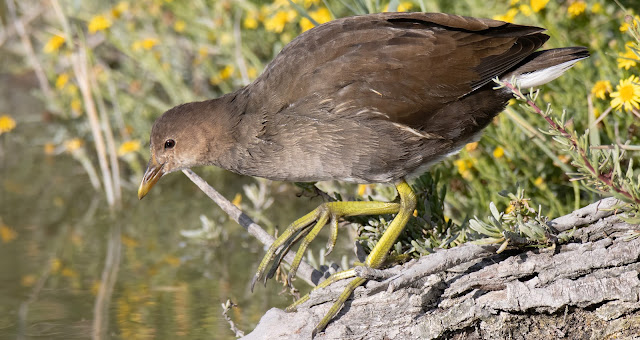 |
| Juveniles ... |
 |
| Adults ... |
 |
| And some adorable fuzzy black chicks with the breed’s signature ginormous feet |
Parc Ornithologique du Pont de Gau boasts of having more than 200 species of birds. I didn't even approach that (I assume that is during a different season), but I did well. I did spend a very long time trying to see a Cetti's Warbler that was singing in a thick bush right off the trail. Merlin identified the song, so I know it was there! I saw movement in the shrub, but never saw the bird. Damn Warblers!!!
Home Base
We stayed at a lovely inn called Mas Fandelou.
It was away from town in a secluded area right on the marshes.
 |
| Left, a giant pine at the entrance; Right, the grounds and our room |
It had a terrace, swimming pool (closed for the season), garden, sun terrace and a delightful non-English-speaking hostess (my High School French was failing me, so we did a lot of gesturing).
I am continually pleased with the wonderful places I find on Booking.com.
 |
| Pretty marshes and too windy for bugs; Photo: Scott Stevens |
The room, on the top floor of a lovely house, was nice, if a bit odd (no door at all on the bathroom and three levels in a small suite).
 |
| Scott, enjoying the setting sun |
But, the grounds were magnificent, with ponds and beautiful sea grasses.
 |
| Peaceful and lovely; Photos: Scott Stevens |
As I mentioned before, the property also had a couple of very friendly Camargue horses.
 |
| Early morning grazing |
And, there were bats and some birds.
 |
| Willow Warbler and House Sparrow (I couldn't capture a bat) |
Breakfast was delicious as well.
 |
| Dining on the pool patio |
And, don't get me started on the sunsets and sunrises.
 |
| And moonrise, as well! |
 |
| C'était magnifique! Photo: Scott Stevens |
Saintes-Maries-de-la-Mer
During our time there, we explored the nearby town of Saintes-Maries-de-la-Mer.
 |
| The "mer" it is by is the Mediterranean |
I kept thinking the “Maries” part was a typo, assuming it should be "Marie," until I read where the town got its name.
.jpg) |
| The Three Marys at the Tomb, Mikołaj Haberschrack |
Previous names of the area were Nôtre-Dame-de-Ratis (Our Lady of the Boat) and Notre-Dame-de-la-Mer (Our Lady of the Sea).
The Church of the Saintes-Maries-de-la-Mer was built from the 9th to the 12th Century as a fortress and a refuge. Allegedly, it can be seen from six miles away (I am not sure why that's important, but apparently it is).
 |
| Photo: Scott Stevens |
The Church has a fresh water well inside, for when the villagers had to take shelter from raiders.
In the 9th Century, the town suffered raids from the Mediterranean Sea by the Vikings and later from the Saracens. In the 15th Century, relics of Marie Salomé and Marie de Cléophas were discovered.
During the anti-clerical fervor of the French Revolution, the church was partially destroyed and the stones recycled.
 |
| Fishing Boats on the Beach at Saintes-Maries |
In 1888, Vincent Van Gogh visited Saintes-Maries-de-la-Mer because he "longed to see a blue sea and a blue sky" and hoped to spend some time drawing. He made several paintings of the seascape and the town. In the early 20th Century, the town was a literary and artistic center, with visits from Ernest Hemingway and Pablo Picasso.
Feast days celebrating the Maries in May draw 25,000-40,000 Catholics to the town for a week, many of whom are Gypsies (Romanies, Manouches, Tziganes and Gitans).
 |
| Saint Sara; Photo: Avignon & Provence |
On successive days, a large crowd carries statues of Sara and the Saintes Maries from the church to the beach, taking them right into the sea.
The dark-skinned Saint Sara is said to have possibly been the Egyptian servant of the three Maries. In another version, Sara was a local woman who welcomed the three Maries on their arrival.
A tourist town, Saintes-Maries-de-la-Mer has shops, restaurants, food stands, white-washed bungalows and a beach.
 |
| A stand specializing in paella |
While I was at the Parc Ornithologique on the second day, Scott went into town to explore.
 |
| A highlight was a vibrant Farmer's Market; Photos: Scott Stevens |
After my time photographing birds, Scott picked me up and showed me the town.
 |
| Lunch! |
We had a lovely lunch where we split two salads: a chicken Caesar (despite being invented in Mexico, quite common in France) and a grilled prawn salad. The enormous prawns were, once again, too strong-flavored for me. But, everything else was amazing.
As I mentioned, we saw lots of tributes to the bulls and bullfighting.
There was a pretty little carousel right next to the bullfight arena.
 |
| So precious |
Plus, we saw many houses and signs adorned with traditional Camargue cross that combines three images: the Latin cross for faith, an anchor for hope and a heart for charity.
 |
| These were all over town |
After walking a bit, we had to finally indulge in ice cream after seeing ice cream shops for days!
 |
| It was delicious! |
 |
| I guess they need revenue |
As we were leaving town, we passed through a tiny roundabout (barely a circle) and were pulled over for failing to signal.
I didn’t even know that signaling was necessary when alone in a small roundabout. It was the equivalent of a speed trap.
The officer was very nice and was excited to ticket his “first American.” For this one, we just paid the fine on the spot. Driving in France is expensive!
When we explored outside of town, we came across more birds in the salt flats.
 |
| Salt flats and the ocean |
Nothing new and no Flamingos, but I got some great photos ...
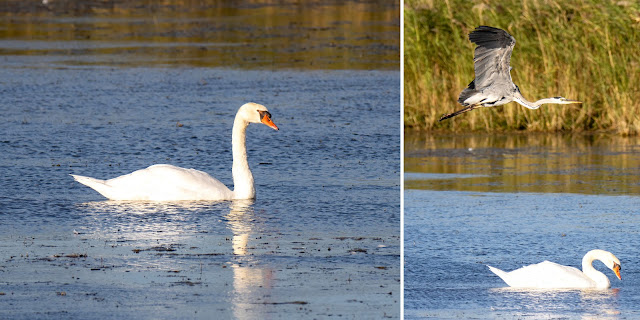 |
| A Mute Swan, with a Gray Heron flying over it ... |
 |
| Gray Heron on the wing ... |
 |
| Little Egret ... |
 |
| A White Stork that posed ... |
 |
| ... and then flew |
The final evening, as I went over upcoming plans, I reiterated to Scott that we would be driving to Provence the next day where we had reservations to tour an Abbey and then I wanted to see a couple of hilltop towns. The next day, we were going on a seven-hour guided wine tour of Chateauneuf du Pape. Because the tour left early, we were staying two nights near Avignon in what I thought was going to be a country Inn.
Scott, who had originally wanted to come to see grape harvest and vineyards, said he didn’t want to spend seven hours on a tour!
 |
| He was satisfied with tour we already took |
It was still cancellable, so I cancelled. We’d figure out what to do once we got to Provence.
Trip Dates: September 4-26, 2024

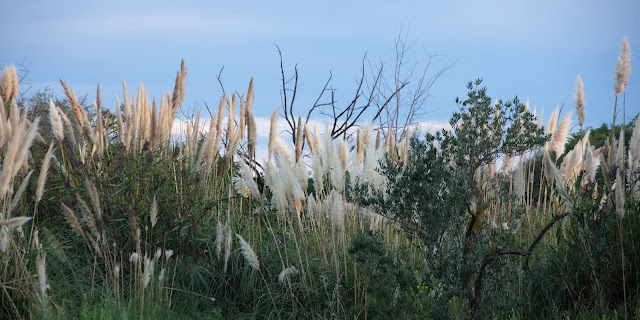








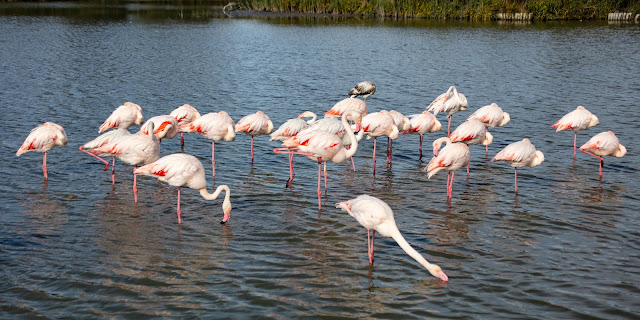



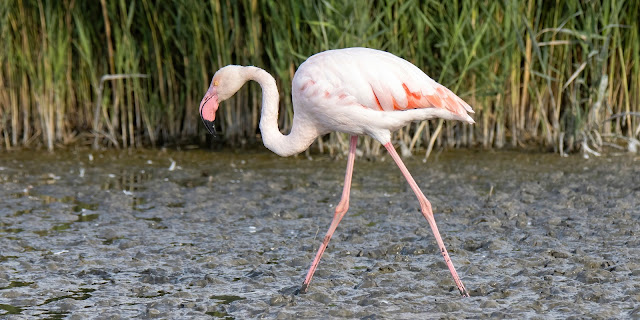


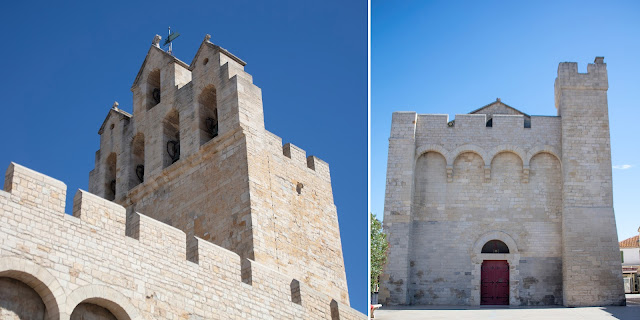

No comments:
Post a Comment